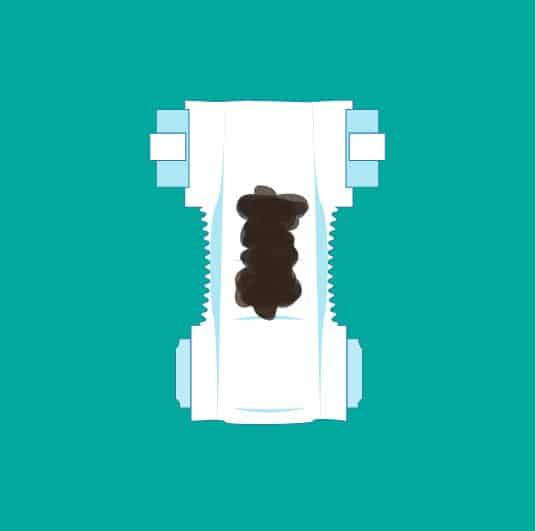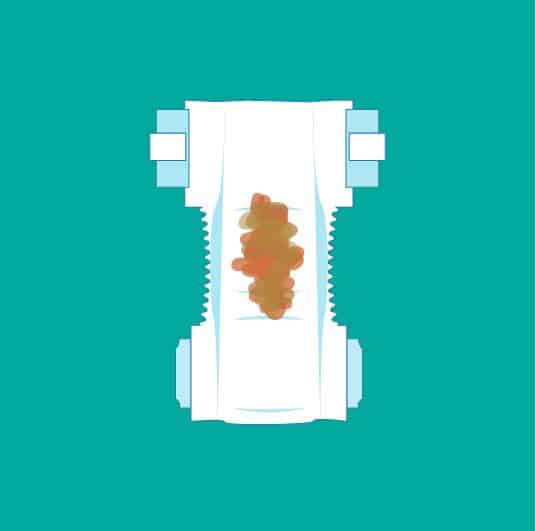As Registered Nurses and International Board Certified Lactation Consultants, we happen to know a lot about poop. Baby poop, that is. And while it is not something that we would put on a resume, we almost consider ourselves the baby poop experts!
We have learned that parents have LOTS of questions about baby poop.
- Too much?
- Too little?
- Too loose?
- Wrong color?
Deciphering the contents of a baby’s diaper can be alarming, especially if you are not sure what to expect. There are the 3 main types of poop you will see in the first week of your baby’s life.
3 Types of Baby Poop

1) meconium
On your baby’s first day of life, you will see meconium poop. It is like black tar, sticks on baby’s skin and does not have a smell. It contains everything that was in baby’s intestines while you were pregnant, including old blood cells, amniotic fluid and mucus. Be happy when you see it: it means that everything is hooked up and working properly!

2) transitional poop
Once your baby has cleared out the meconium, you will begin to see transitional poop. It is brown or green in color and not as glued onto baby’s bum. It may contain milk curds or “seeds”. Transitional poop generally appears after baby’s first day of life and gradually gives way to the third type of poop.

3) milk poops
Around the third day of baby’s life, you will begin to see milk poops.
Breastfed babies will have very loose, yellow, curdy poops, much like mustard. The poops can be very frequent, sometimes every time the baby eats! This is not diarrhea and your baby is not dehydrated. This type of poop means that baby is getting enough to drink and is probably gaining weight. Hooray!
The poops of formula fed babies will differ slightly. Their stools are typically more “pasty”, the consistency of peanut butter. They tend to be a bit more infrequent and a bit larger. The color can vary from yellow to tan and they are likely to have an odor.
Babies receiving both breastmilk and formula will have some combination of the above.
If pictures speak louder than words for you, (and you have a strong stomach) click here to see actual photos of diaper contents.
Aside from poop, there can be 3 other diaper surprises you should know about.
1) Mini period: If you have a baby girl, don’t be alarmed if you notice a little blood in her diaper in her first 2 weeks. It is normal for newborn girls to have mini period (fancy name: pseudomenstruation). Pseudomenstruation is due to the hormones mom passed on to her before she was born. Nothing to worry about; no need to panic. Simply normal.
2) Discharge: The hormones that cause pseudomenstruation can also cause baby girls to have a thick, white mucousy discharge from her vagina. This too is normal. By the time she is 2 weeks old, this will be gone as well.
3) “Brick dust” in the diaper is another frequent cause of false alarm; it is often mistaken for blood. In babies’ first 2 or 3 days, their urine (pee) is concentrated; uric acid crystals can be visible. These crystals are pinky-orange or reddish in color (hence the name). Brick dust is normal in baby’s few days but it is NOT normal once baby is about 5 days old. I would definitely recommend an assessment by a breastfeeding specialist to ensure baby is getting enough to drink. Click here to see a pic.
Poops of Concern:
There are lots of shock producing diaper contents that are absolutely normal. There are also a few diaper contents that bear closer attention. Consult your health care provider if you notice any of the following:
- Blood in your baby’s poop.
- Dark sticky poop (meconium) after baby’s 4th day of life.
- No poop in the last 24 hours and your baby is less than 3 weeks old. This can be normal for some babies but it is best to make sure baby is drinking well.
Baby Poop Summary
Over the last 20 years as nurses working with new families, we have seen a lot of it, smelled a lot of it and have even held a handful of it after weighing a naked baby. We have gone home with it on our shoes, on our pants… well, you get the picture! Baby poop can be alarming but if you're a parent, it will take no time at all to become an expert.
Our next reco: Types of Baby Rashes




Leave a Comment